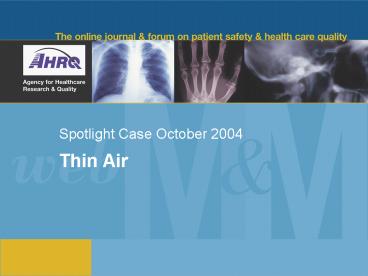Spotlight Case October 2004 - PowerPoint PPT Presentation
1 / 19
Title:
Spotlight Case October 2004
Description:
Tubing connected to green Christmas tree adapter which was inadvertently ... Permanently fix Christmas tree adapters to the correct flowmeter ... – PowerPoint PPT presentation
Number of Views:46
Avg rating:3.0/5.0
Title: Spotlight Case October 2004
1
Spotlight Case October 2004
- Thin Air
2
Source and Credits
- This presentation is based on the Oct. 2004 AHRQ
WebMM Spotlight Case in Medicine - See the full article at http//webmm.ahrq.gov
- CME credit is available through the Web site
- Commentary by David M. Gaba, MD, Stanford
University School of Medicine - Editor, AHRQ WebMM Robert Wachter, MD
- Spotlight Editor Tracy Minichiello, MD
- Managing Editor Erin Hartman, MS
3
Objectives
- At the conclusion of this educational activity,
participants should be able to - Identify the gas-specific non-interchangeable
connectors used for bulk gas supply outlets in
hospitals - Define forcing function, both in engineered
safety devices and in human procedures - Review strategies to prevent delivery of wrong
gas to hospitalized patients
4
Case Thin Air
- A 73-year-old woman was admitted with fever and
back pain. She was diagnosed with pyelonephritis.
The morning after admission, she became
hypotensive and short of breath. Her oxygen
saturations were 70. She was placed on high-flow
oxygen with little benefit. A chest x-ray showed
diffuse pulmonary infiltrates consistent with
acute respiratory distress syndrome (ARDS).
5
Case (cont.) Thin Air
- The patient was intubated for hypoxemic
respiratory failure. Shortly thereafter, the
respiratory therapist arrived and noticed that
the patient was being treated with compressed
airnot oxygen.
6
Oxygen and Air Flowmeters With Correct Adapters
Green, thin adapter on green O2 flowmeter
7
Air and Oxygen Flowmeters With Adapters Swapped
Green adapter placed incorrectly on yellow
compressed air flowmeter
8
What Went Wrong in This Case
- Tubing connected to green Christmas tree adapter
which was inadvertently connected to the air port
instead of oxygen port - OR
- Tubing connected to yellow Christmas tree
adapter (instead of green Christmas tree adapter)
which was connected to air port
9
The Scope of the Problem
- The frequency of tubing/flowmeter swaps is
unknown, but it is often enough that a Patient
Safety Advisory was issued by the Veterans Health
Administration Warning System in March 2002 - Probably more common that oxygen tubing becomes
disconnected from a correct flowmeter during a
resuscitation
10
Case (cont.) Thin Air
- The patient was transferred to intensive care
and died the next day of overwhelming sepsis and
systemic inflammatory response syndrome (SIRS).
11
Human Factors Engineering Approach
- Rely on improving design of artifacts in the
world rather than relying on instructions,
training, labels, or the usual admonition to be
more careful - Forcing functions
- Engineered safety devices
- Procedural forcing functions
12
Engineered Safety Devices
- Engineered Safety Device a physical arrangement
that precludes the wrong action - Examples include
- Diameter Index Safety System (DISS)physically
impossible to insert oxygen hose or flowmeter
into any other port, or to attach anything
inappropriate to oxygen port
Norman D. The psychology of everyday things. 1988.
13
Engineered Safety Devices (cont.)
- Pin Index Systemeach cylinder has specific
pattern of holes into which matching pins from
appropriate regulator must fit - Oxygen proportion limiting control system
physically prevents selecting an oxygen
concentration of less than 25 - Mechanical vaporizer lockprevents activating
more than one vaporizer delivering a volatile
anesthetic gas at a time
Petty C. The anesthesia machine. 1987 In
Ehrenwerth J, et al, eds. Anesthesia equipment.
1993 In Miller RD, ed. Anesthesia. 2000.
14
Diameter Index Safety System (DISS)
15
Yet Mistakes Still Happen
- The threaded output of the flowmeter is one size
fits all and fits yellow, green, and clear
color-coded Christmas tree adapters - Oxygen tubing fits non-oxygen flowmeters
16
Implementing Engineered Safety Devices
- Extend the diameter index system to flowmeter
output port or have Christmas tree adapters
molded into device - Create gas-specific non-interchangeable fitting
for low pressure oxygen tubing
17
Procedural Forcing Functions
- Standard procedures call for personnel to verify
certain conditions before proceeding - Verification of blood products prior to
transfusion - Timeout prior to surgical incision to decrease
incidence of wrong site surgery - Procedural forcing functions limited due to
psychological factors such as haste, complacency,
and social shirking
Heimann C. Acceptable risks politics, policy,
and risky technologies. 1997.
18
Take-Home Points
- Consider strategies to reduce the likelihood of
connecting oxygen tubing to the wrong gas - Eliminate air flowmeters
- Permanently fix Christmas tree adapters to the
correct flowmeter - Use clear Christmas tree adapters rather than
color-coded ones that way, the adapter conveys
no information and forces the user to look at the
flowmeter to identify the gas
19
Take-Home Points
- Consider the possibility that the wrong gas (or
no gas) is being administered when a patient does
not respond to treatment with supplemental
oxygen double check the flowmeter and tubing
connections - Implement engineered safety devices when possible
rather than procedural forcing functions































